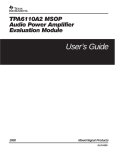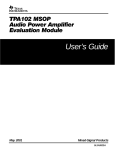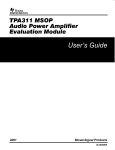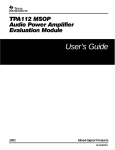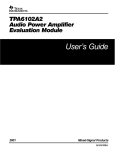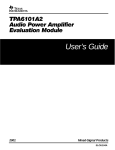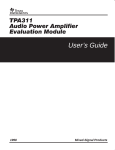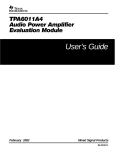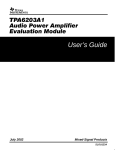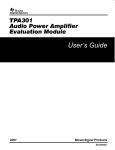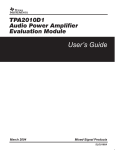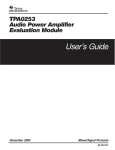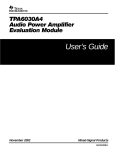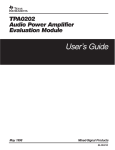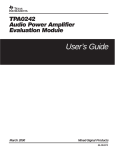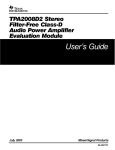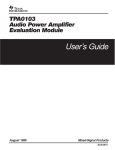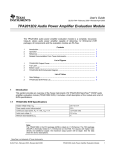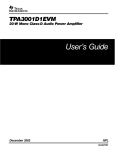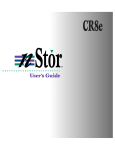Download Texas Instruments TPA701 User's Manual
Transcript
TPA701 MSOP Audio Power Amplifier Evaluation Module User’s Guide November 1998 Mixed-Signal Products SLOU026A IMPORTANT NOTICE Texas Instruments and its subsidiaries (TI) reserve the right to make changes to their products or to discontinue any product or service without notice, and advise customers to obtain the latest version of relevant information to verify, before placing orders, that information being relied on is current and complete. All products are sold subject to the terms and conditions of sale supplied at the time of order acknowledgement, including those pertaining to warranty, patent infringement, and limitation of liability. TI warrants performance of its semiconductor products to the specifications applicable at the time of sale in accordance with TI’s standard warranty. Testing and other quality control techniques are utilized to the extent TI deems necessary to support this warranty. Specific testing of all parameters of each device is not necessarily performed, except those mandated by government requirements. CERTAIN APPLICATIONS USING SEMICONDUCTOR PRODUCTS MAY INVOLVE POTENTIAL RISKS OF DEATH, PERSONAL INJURY, OR SEVERE PROPERTY OR ENVIRONMENTAL DAMAGE (“CRITICAL APPLICATIONS”). TI SEMICONDUCTOR PRODUCTS ARE NOT DESIGNED, AUTHORIZED, OR WARRANTED TO BE SUITABLE FOR USE IN LIFE-SUPPORT DEVICES OR SYSTEMS OR OTHER CRITICAL APPLICATIONS. INCLUSION OF TI PRODUCTS IN SUCH APPLICATIONS IS UNDERSTOOD TO BE FULLY AT THE CUSTOMER’S RISK. In order to minimize risks associated with the customer’s applications, adequate design and operating safeguards must be provided by the customer to minimize inherent or procedural hazards. TI assumes no liability for applications assistance or customer product design. TI does not warrant or represent that any license, either express or implied, is granted under any patent right, copyright, mask work right, or other intellectual property right of TI covering or relating to any combination, machine, or process in which such semiconductor products or services might be or are used. TI’s publication of information regarding any third party’s products or services does not constitute TI’s approval, warranty or endorsement thereof. Copyright 1998, Texas Instruments Incorporated Preface Related Documentation From Texas Instruments J J TI Plug-N-Play Audio Amplifier Evaluation Platform (literature number SLOU011) provides detailed information on the evaluation platform and its use with TI audio evaluation modules. TPA701 700-mW LOW-VOLTAGE AUDIO POWER AMPLIFIER (literature number SLOS229) This is the data sheet for the TPA701 audio amplifier integrated circuit. FCC Warning This equipment is intended for use in a laboratory test environment only. It generates, uses, and can radiate radio frequency energy and has not been tested for compliance with the limits of computing devices pursuant to subpart J of part 15 of FCC rules, which are designed to provide reasonable protection against radio frequency interference. Operation of this equipment in other environments may cause interference with radio communications, in which case the user at his own expense will be required to take whatever measures may be required to correct this interference. Trademarks TI is a trademark of Texas Instruments Incorporated. Chapter Title—Attribute Reference iii iv Running Title—Attribute Reference Contents 1 Introduction . . . . . . . . . . . . . . . . . . . . . . . . . . . . . . . . . . . . . . . . . . . . . . . . . . . . . . . . . . . . . . . . . . . . . 1.1 Feature Highlights . . . . . . . . . . . . . . . . . . . . . . . . . . . . . . . . . . . . . . . . . . . . . . . . . . . . . . . . . . 1.2 Description . . . . . . . . . . . . . . . . . . . . . . . . . . . . . . . . . . . . . . . . . . . . . . . . . . . . . . . . . . . . . . . . 1.3 TPA701 EVM Specifications . . . . . . . . . . . . . . . . . . . . . . . . . . . . . . . . . . . . . . . . . . . . . . . . . . 1-1 1-2 1-3 1-4 2 Quick Start . . . . . . . . . . . . . . . . . . . . . . . . . . . . . . . . . . . . . . . . . . . . . . . . . . . . . . . . . . . . . . . . . . . . . . 2.1 Precautions . . . . . . . . . . . . . . . . . . . . . . . . . . . . . . . . . . . . . . . . . . . . . . . . . . . . . . . . . . . . . . . . 2.2 Quick Start List for Platform . . . . . . . . . . . . . . . . . . . . . . . . . . . . . . . . . . . . . . . . . . . . . . . . . . 2.3 Quick Start List for Stand-Alone . . . . . . . . . . . . . . . . . . . . . . . . . . . . . . . . . . . . . . . . . . . . . . 2-1 2-2 2-3 2-4 3 Details . . . . . . . . . . . . . . . . . . . . . . . . . . . . . . . . . . . . . . . . . . . . . . . . . . . . . . . . . . . . . . . . . . . . . . . . . . 3-1 3.1 Precautions . . . . . . . . . . . . . . . . . . . . . . . . . . . . . . . . . . . . . . . . . . . . . . . . . . . . . . . . . . . . . . . . 3-2 3.2 The TPA701 MSOP Audio Amplifier Evaluation Module . . . . . . . . . . . . . . . . . . . . . . . . . . 3-3 3.2.1 TPA701 Audio Amplifier IC . . . . . . . . . . . . . . . . . . . . . . . . . . . . . . . . . . . . . . . . . . . . 3-4 3.2.2 BTL Operation . . . . . . . . . . . . . . . . . . . . . . . . . . . . . . . . . . . . . . . . . . . . . . . . . . . . . . 3-4 3.2.3 Module Gain . . . . . . . . . . . . . . . . . . . . . . . . . . . . . . . . . . . . . . . . . . . . . . . . . . . . . . . . 3-4 3.2.4 Shutdown . . . . . . . . . . . . . . . . . . . . . . . . . . . . . . . . . . . . . . . . . . . . . . . . . . . . . . . . . . 3-5 3.3 Using The TPA701 MSOP EVM With The Plug-N-Play Evaluation Platform . . . . . . . . . 3-6 3.3.1 Installing and Removing EVM Boards . . . . . . . . . . . . . . . . . . . . . . . . . . . . . . . . . . 3-6 3.3.2 Signal Routing . . . . . . . . . . . . . . . . . . . . . . . . . . . . . . . . . . . . . . . . . . . . . . . . . . . . . . 3-7 3.3.3 Mute/Mode . . . . . . . . . . . . . . . . . . . . . . . . . . . . . . . . . . . . . . . . . . . . . . . . . . . . . . . . . 3-7 3.3.4 Power Requirements . . . . . . . . . . . . . . . . . . . . . . . . . . . . . . . . . . . . . . . . . . . . . . . . . 3-9 3.3.5 Inputs and Outputs . . . . . . . . . . . . . . . . . . . . . . . . . . . . . . . . . . . . . . . . . . . . . . . . . . 3-9 3.4 Using The TPA701 MSOP EVM Stand-ALone . . . . . . . . . . . . . . . . . . . . . . . . . . . . . . . . . 3-11 3.4.1 TPA701 MSOP EVM Connected for BTL Output . . . . . . . . . . . . . . . . . . . . . . . . 3-11 3.5 TPA701 MSOP Audio Amplifier Evaluation Module Parts List . . . . . . . . . . . . . . . . . . . . 3-12 Chapter Title—Attribute Reference v Running Title—Attribute Reference Figures 1–1 2–1 2–2 3–1 3–2 3–3 3–4 3–5 3–6 3–7 3–8 The TI TPA701 MSOP Audio Amplifier Evaluation Module . . . . . . . . . . . . . . . . . . . . . . . . . . 1-3 Quick Start Platform Map . . . . . . . . . . . . . . . . . . . . . . . . . . . . . . . . . . . . . . . . . . . . . . . . . . . . . . 2-2 Quick Start Module Map . . . . . . . . . . . . . . . . . . . . . . . . . . . . . . . . . . . . . . . . . . . . . . . . . . . . . . . 2-4 The TI Plug-N-Play Audio Amplifier Evaluation Platform . . . . . . . . . . . . . . . . . . . . . . . . . . . . 3-2 TPA701 MSOP EVM . . . . . . . . . . . . . . . . . . . . . . . . . . . . . . . . . . . . . . . . . . . . . . . . . . . . . . . . . . 3-3 TPA701 MSOP EVM Schematic Diagram . . . . . . . . . . . . . . . . . . . . . . . . . . . . . . . . . . . . . . . . 3-3 TPA701 Audio Amplifier IC . . . . . . . . . . . . . . . . . . . . . . . . . . . . . . . . . . . . . . . . . . . . . . . . . . . . . 3-4 Platform Signal Routing and Outputs . . . . . . . . . . . . . . . . . . . . . . . . . . . . . . . . . . . . . . . . . . . . 3-7 Mute/Mode and Polarity Control . . . . . . . . . . . . . . . . . . . . . . . . . . . . . . . . . . . . . . . . . . . . . . . . . 3-8 Typical Headphone Plug . . . . . . . . . . . . . . . . . . . . . . . . . . . . . . . . . . . . . . . . . . . . . . . . . . . . . . 3-10 TPA701 MSOP EVM Connected for Stereo BTL Output . . . . . . . . . . . . . . . . . . . . . . . . . . . 3-11 Tables 2–1 2–2 3–1 vi Typical TI Plug-N-Play Platform Jumper and Switch Settings for the TPA701 MSOP EVM . . . . . . . . . . . . . . . . . . . . . . . . . . . . . . . . . . . . . . . . . . . . . . . . . . . . . . . . . . 2-1 Platform Jumper and Switch Settings for the TPA701 MSOP EVM . . . . . . . . . . . . . . . . . . . 2-3 TPA701 MSOP EVM Parts List . . . . . . . . . . . . . . . . . . . . . . . . . . . . . . . . . . . . . . . . . . . . . . . . 3-12 Chapter 1 Introduction This chapter provides an overview of the Texas Instruments (TI) TPA701 MSOP Audio Amplifier Evaluation Module (SLOP213). It includes a list of EVM features, a brief description of the module illustrated with a pictorial diagram, and a list of EVM specifications. Topic Page 1.1 Feature Highlights . . . . . . . . . . . . . . . . . . . . . . . . . . . . . . . . . . . . . . . 1–2 1.2 Description . . . . . . . . . . . . . . . . . . . . . . . . . . . . . . . . . . . . . . . . . . . . . 1–3 1.3 TPA701 MSOP EVM Specifications . . . . . . . . . . . . . . . . . . . . . . . . . 1–4 Introduction 1-1 Feature Highlights 1.1 Feature Highlights The TI TPA701 MSOP Audio Amplifier Evaluation Module and the TI Plug-N-Play Audio Amplifier Evaluation Platform include the following features: - - TPA701 Low-Voltage Audio Power Amplifier Evaluation Module J J J J J J - 1-2 3.3-V and 5-V operation 700-mW output power into 8 Ω at 5 V, BTL Ultra-low current consumption in shutdown mode Internal thermal and short-circuit protection Module gain is set at –4 V/V in BTL mode, –2 V/V in SE mode Quick and Easy Configuration with The TI Plug-N-Play Audio Amplifier Evaluation Platform J - Single channel, bridge-tied load (BTL) J J J J Evaluation module is designed to simply plug into the platform, automatically making all signal, control, and power connections Platform provides flexible power options Jumpers on the platform select power and module control options Switches on the platform route signals Platform provides quick and easy audio input and output connections Platform Power Options J J J J J On-board 9-V battery External 5-V – 15-V (VCC) supply inputs External regulated VDD supply input Socket for on-board 5 V/3.3 V VDD voltage regulator EVM On-board overvoltage and reverse polarity power protection Platform Audio Input and Output Connections J J J J J Left and right RCA phono jack inputs Miniature stereo phone jack input Left and right RCA phono jack outputs Left and right compression speaker terminal outputs Miniature stereo headphone jack output Introduction Description 1.2 Description The TPA701 MSOP Audio Power Amplifier Evaluation Module is a complete, low-power single-channel audio power amplifier. It consists of the TI TPA701 700-mW Low-Voltage Audio Power Amplifier IC in a very small MSOP package, along with a small number of other parts mounted on a circuit board that is approximately one and a quarter inches square (Figure 1–1). Figure 1–1. The TI TPA701 Audio Amplifier Evaluation Module Vdd GND Shutdown + C3 S1 R1 U1 † C1 C4 R2 C2 R3 OUT– GND OUT+ C5 TEXAS INSTRUMENTS IN GND SLOP213 TPA701 MSOP EVM † Due to the very small size of the MSOP IC package, the standard part number TPA701 is replaced with the code TIABA. Single in-line header pins are mounted to the underside of the module circuit board to allow the EVM to be plugged into the TI Plug-N-Play Audio Amplifier Evaluation Platform or to be wired directly into existing circuits and equipment when used stand-alone. The platform has room for a pair of TPA701 MSOP evaluation modules and is a convenient vehicle for demonstrating TI’s audio power amplifier and related evaluation modules. The EVMs simply plug into the platform, which automatically provides power to the modules, interconnects them correctly, and connects them to a versatile array of standard audio input and output jacks and connectors. Easy-to-use configuration controls allow the platform and EVMs to quickly model many possible end-equipment configurations. There is nothing to build, nothing to solder, and nothing but the speakers included with the platform to hook up. Introduction 1-3 TPA701 EVM Specifications 1.3 TPA701 EVM Specifications Supply voltage range, VDD . . . . . . . . . . . . . . . . . . . . . . . . . . . . . . . . . . . . . . . . . . . . . . 2.5 V to 5.5 V Supply current, IDD . . . . . . . . . . . . . . . . . . . . . . . . . . . . . . . . . . . . . . . . . . . . . . . . . . . . . 450 mA, max Continuous output power, PO: 8-Ω BTL, VDD = 5 V . . . . . . . . . . . . . . . . . . . . . . . . . . . . . . 700 mW Audio input voltage, VI . . . . . . . . . . . . . . . . . . . . . . . . . . . . . . . . . . . . . . . . . . . . . . . . . . . . 2 Vpp, max Minimum load impedance, RL . . . . . . . . . . . . . . . . . . . . . . . . . . . . . . . . . . . . . . . . . . . . . . . . . . . . 8 Ω 1-4 Introduction Chapter 2 Quick Start The steps in this chapter can be followed to quickly prepare the TPA701 MSOP audio amplifier EVM for use. Using the TPA701 MSOP EVM with the TI Plug-N-Play Audio Amplifier Evaluation Platform is a quick and easy way to connect power, signal and control inputs, and signal outputs to the EVM, using standard connectors. However, the audio amplifier evaluation module can be used stand-alone by making connections directly to the module pins, and it can be wired directly into existing circuits or equipment. The platform switch and jumper settings shown in Table 2–1 are typical for the TPA701 MSOP EVM. They will cause the TPA701 device to shutdown when a plug is inserted into platform headphone jack J10. Table 2–1. Typical TI Plug-N-Play Platform Jumper and Switch Settings for the TPA701 MSOP EVM EVM JP6 JP7 JP8 S2 S3 TPA701 Mute X Hi Note 2 X Notes: 1) X = Don’t care 2) Set S2 to ON when signal conditioning board is installed in U1; set S2 to OFF when no signal conditioning board is installed. Topic Page . . . . . . . . . . . . . . . . . . . . . . . . . . . . . . . . . . . . . . . . . . . . 2–2 2.1 Precautions 2.2 Quick Start List for Platform . . . . . . . . . . . . . . . . . . . . . . . . . . . . . . . 2–3 2.3 Quick Start List for Stand-Alone . . . . . . . . . . . . . . . . . . . . . . . . . . . 2–4 Quick Start 2-1 Precautions 2.1 Precautions Power Supply Input Polarity and Maximum Voltage Always ensure that the polarity and voltage of the external power connected to VCC power input connector J1, J2, and/or VDD power input connector J6 are correct. Overvoltage or reverse-polarity power applied to these terminals can open on-board soldered-in fuses and cause other damage to the platform, installed evaluation modules, and/or the power source. Inserting or Removing EVM Boards Do not insert or remove EVM boards with power applied – damage to the EVM board, the platform, or both may result. Figure 2–1. Quick Start Platform Map 6b ICC + Right – Out 9 U2 U1 U4 + Left – Out J5 On Conditioning Speaker Output 5 JP6 + 4 Stereo Headphone Output J10 + S3 HP Source R4 Left J9 Out Spk(U2-U4) C3 C2 JP8 JP7 HP(U5) U2-U4 U5 U5 TP1 GND TEXAS INSTRUMENTS 1997 Mode Mute Polarity Lo Hi R3 3 Out LED2 VDD U3 Off S2 J4 Left In Plug-N-Play Audio Amplifier Evaluation Platform SLOP097 Rev. C.1 J7 Right J8 JP5 IDD LED1 VCC J3 Stereo In ****CAUTION**** Do not insert or remove EVM boards with power applied DC Power In/Out J6 VDD In/Out D1 D2 D3 Right In Audio Input 2-2 R2 Audio Power Amps Signal Conditioning 8 + B1 D4 J2 AC/DC In R1 6a F2 6b Power Input VR2 S1 U6 POWER SUPPLY JP4 Pwr VR1 On Off JP3 Batt JP2 AC/DC J1 VCC In + JP1 (J2) VCC(J1) DC SOURCE F1 C1+ 6b 6b 1 10 HP Out R5 2 Quick Start Quick Start List for Platform 2.2 Quick Start List for Platform - Follow these steps when using the TPA701 MSOP EVM with the TI Plug-N-Play Audio Amplifier Evaluation Platform (see the platform user’s guide, SLOU011, for additional details). Numbered callouts for selected steps are shown in Figure 2–1 and details appear in Chapter 3. Platform preparations 1) Ensure that all external power sources are set to OFF and that the platform power switch S1 is set to OFF. 2) Install a TPA701 MSOP module in platform sockets U3 and U4 for stereo operation (or a module in either U3 or U4 for single channel operation), taking care to align the module pins correctly. 3) Use switch S2 to select or bypass the signal conditioning EVM (U1). 4) Set control signal Polarity jumper JP8 to Hi. 5) Set jumper JP6 to select the Mute control input (causes the TPA701 to shutdown if a plug is inserted into platform headphone jack J10). Table 2–2. Platform Jumper and Switch Settings for the TPA701 MSOP EVM EVM JP6 JP7 JP8 S2 S3 TPA701 Mute X Hi Note 2 X Notes: - 1) X = Don’t care 2) Set S2 to ON when signal conditioning board is installed in U1; set S2 to OFF when no signal conditioning board is installed. Power supply 6) Select and connect the power supply: a) Connect an external regulated power supply set to a voltage between 2.5 V and 5.5 V to platform VDD power input connector J6, taking care to observe marked polarity, or - b) Install a voltage regulator EVM (SLVP097 or equiv.) in platform socket U6. Install a 9-V battery in B1 or connect a 7 V – 12 V power source to a platform VCC power input J1 or J2 and jumper the appropriate power input (see platform user’s guide). Inputs and outputs 7) Ensure that signal source level is set to minimum. 8) Connect the audio source to left and right RCA phono jacks J3 and J5 or stereo miniature phone jack J4. - 9) Connect 8-Ω – 32-Ω speakers to left and right RCA jacks J7 and J9 or to stripped wire connectors J8. Power-up 10) Verify correct voltage and input polarity and set the external power supply to ON. If VCC and an on-board regulator EVM are used to provide VDD, set platform power switch S1 to ON. Platform LED2 should light indicating the presence of VDD, and the evaluation modules installed on the platform should begin operation. 11) Adjust the signal source level as needed. Quick Start 2-3 Quick Start List for Stand-Alone 2.3 Quick Start List for Stand-Alone Follow these steps to use the TPA701 MSOP EVM stand-alone or when connecting it into existing circuits or equipment. Connections to the TPA701 MSOP module header pins can be made via individual sockets, wire-wrapping, or soldering to the pins, either on the top or the bottom of the module circuit board. Numbered callouts for selected steps are shown in Figure 2–2 and details appear in Chapter 3. Figure 2–2. Quick Start Module Map 2 Vdd GND Shutdown + 5 C3 S1 R1 U1 † C1 C4 R2 C2 R3 OUT– GND 6 OUT+ C5 TEXAS INSTRUMENTS 4 IN GND SLOP213 TPA701 MSOP EVM † Due to the very small size of the MSOP IC package, the standard part number TPA701 is replaced with the code TIABA - Power supply 1) Ensure that all external power sources are set to OFF. - 2) Connect an external regulated power supply set to 5 V to the module Vdd and GND pins, taking care to observe marked polarity. Inputs and outputs 3) Ensure that the signal source level is set to minimum. 4) Connect the audio source to the module IN and GND pins, taking care to observe marked polarity. 5) Connect the Shutdown (S1) pin to VDD through a Normally Open switch. - 6) Connect an 8-Ω – 32-Ω speaker to the module OUT+ and OUT– pins. Power-up 7) Verify correct voltage and input polarity and set the external power supply to ON. The EVM should begin operation. 8) Adjust the signal source level as needed. 2-4 Quick Start Chapter 3 Details This chapter provides details on the TPA701 IC, the evaluation module, the steps in the Quick-Start List, additional application information, and a parts list for the TPA701 MSOP evaluation module. Topic Page . . . . . . . . . . . . . . . . . . . . . . . . . . . . . . . . . . . . . . . . . . . . 3–2 3.1 Precautions 3.2 The TPA701 MSOP Audio Power Amplifier Evaluation Module 3.3 Using The TPA701 MSOP EVM With The Plug-N-Play Evaluation Platform . . . . . . . . . . . . . . . . . . . . . . . . . . . . . . . . . . . . . . . . . . . 3–6 3.4 Using The TPA701 MSOP EVM Stand-Alone . . . . . . . . . . . . . . . . . . . . 3–11 3.5 TPA701 MSOP Audio Power Amplifier Evaluation Module Parts List . . . . . . . . . . . . . . . . . . . . . . . . . . . . . . . . . . . . . . . . . . . 3–12 Details . . 3–3 3-1 Precautions 3.1 Precautions Power Supply Input Polarity and Maximum Voltage Always ensure that the polarity and voltage of the external power connected to VCC power input connector J1, J2, and/or VDD power input connector J6 are correct. Overvoltage or reverse-polarity power applied to these terminals can open on-board soldered-in fuses and cause other damage to the platform, installed evaluation modules, and/or the power source. Inserting or Removing EVM Boards Do not insert or remove EVM boards with power applied – damage to the EVM board, the platform, or both may result. Figure 3–1. The TI Plug-N-Play Audio Amplifier Evaluation Platform VR2 F2 U6 POWER SUPPLY S1 + Right – Out U2 U1 JP6 + Stereo Headphone Output J10 R4 + S3 HP Source R3 Left J9 Out Spk(U2-U4) C3 C2 JP8 Mode Mute Polarity Lo Hi JP7 HP(U5) U2-U4 U5 U5 TP1 GND TEXAS INSTRUMENTS 1997 Plug-N-Play Audio Amplifier Evaluation Platform SLOP097 Rev. C.1 Speaker Output + Left – Out U4 On Conditioning J5 Left In ****CAUTION**** Do not insert or remove EVM boards with power applied Out LED2 VDD U3 Off S2 J4 Stereo In Audio Input DC Power In/Out J7 Right J8 JP5 IDD LED1 VCC J3 Right In R2 Audio Power Amps + J6 D1 D2 D3 VDD In/Out B1 D4 J2 AC/DC In R1 Signal Conditioning 3-2 ICC JP4 Pwr VR1 On Off JP3 Batt JP2 AC/DC J1 JP1 (J2) VCC(J1) DC SOURCE VCC In + Power Input F1 C1+ HP Out R5 Details The TPA701 MSOP Audio Power Amplifier Evaluation Module 3.2 The TPA701 MSOP Audio Power Amplifier Evaluation Module The TPA701 MSOP Audio Power Amplifier Evaluation Module is powered by a TPA701 700-mW Low-Power Audio Amplifier IC and includes an on-board shutdown control signal switch. The module can be used with the TI Plug-N-Play Audio Amplifier Evaluation Platform (Figure 3 –1) or wired directly into circuits or equipment. The module has single in-line header connector pins mounted to the under side of the board. These pins allow the module to be plugged into the TI platform, which automatically makes all the signal input and output, power, and control connections to the module. The module connection pins are on 0.1-inch centers to allow easy use with standard perf board and plug board-based prototyping systems. Or, the EVM can be wired directly into existing circuits and equipment when used stand-alone. The module appears in Figure 3–2 and its schematic is shown in Figure 3 – 3. Figure 3–2. TPA701 MSOP EVM Vdd GND Shutdown + C3 S1 R1 U1 † C1 C4 R2 C2 R3 OUT– GND OUT+ C5 TEXAS INSTRUMENTS IN GND SLOP213 TPA701 MSOP EVM † Due to the very small size of the MSOP IC package, the standard part number TPA701 is replaced with the code TIABA Figure 3–3. TPA701 MSOP EVM Schematic Diagram S1 No Shutdown R1 20 kΩ 1 2 C1 1 µF 3 4 Shutdown VO – Bypass GND In+ VDD In – VO + 7 6 5 OUT– C4 1 µF GND OUT+ C2 1 µF Audio Input– GND VDD 2.5 V to 5.5 V C3 GND 10 µF + 8 R2 20 kΩ R3 39 kΩ C5 5 pF Details 3-3 The TPA701 MSOP Audio Power Amplifier Evaluation Module 3.2.1 TPA701 Audio Amplifier IC The TPA701 audio amplifier IC is a CMOS device intended for bridge-tied load (BTL) operation in battery-powered applications. It is supplied in a very small surface-mount package and has been designed to operate from low supply voltages (between approximately 2.5 V and 5.5 V) and deliver up to approximately 700 mW into an 8-Ω, BTL (Figure 3 – 4). Typical applications include portable phones, toys, games, and similar hand-held audio applications. Figure 3–4. TPA701 Amplifier IC 4 _ IN – 3 IN+ + 5 OUT+ 6 VDD 2 VDD/2 _ BYPASS 7 + GND 1 8 OUT– Bias Control SHUTDOWN The IC includes two separate internal amplifiers. The two amplifiers operate as mirror images of each other for increased power. BTL operation provides many benefits, including quadruple the output power of single-ended operation and no need for bulky output coupling capacitors. For more information, see the TPA701 amplifier IC data sheet, TI Literature Number SLOS229. 3.2.2 BTL Operation The output signal from OUT+ must go through the speaker load and be returned directly to OUT–, and NOT to system ground. This requires that the OUT– line be isolated not only from system ground, but also from the OUT– lines of any other amplifiers in the system. The platform provides such isolated output lines from the amplifier EVM sockets directly to separate left and right speaker connectors. 3.2.3 Module Gain The TPA701 MSOP evaluation module has a set gain of 2. However, the gain can be adjusted to a maximum of 22 by changing the value of resistor R3 (Figure 3–3). Use the following equation to determine value of R3: Gain + –RR3 2 for BTL 2 3-4 Details The TPA701 MSOP Audio Power Amplifier Evaluation Module The TPA701 amplifier IC, like most other amplifiers, exhibits its best distortion and noise performance at lower gain levels (see the TPA701 data sheet). Even so, the TPA701 at its highest gain setting has significantly less distortion than most low-cost speakers. Gain versus total harmonic distortion (THD) should be considered in each application. Both the module input signal level and the TPA701 MSOP module gain should be adjusted to obtain the lowest overall distortion level for a particular overall gain. A quick rule of thumb (everything else being equal): the module input signal level should be as high as possible without clipping or overloading the TPA701 input, and the TPA701 gain should be kept as low as possible. 3.2.4 Shutdown When the shutdown terminal of the TPA701 amplifier IC is taken high, the IC ceases operation and enters an ultra-low power state. This is accomplished by applying a control signal to the module Shutdown pin or by pressing the Shutdown switch, S1, on the module. When the control signal goes low or is removed (or the switch is released), amplifier operation resumes. The Plug-N-Play platform can generate the shutdown (mute) signal for the module either when a plug is inserted into the platform headphone output jack or when the plug is removed, as selected by a platform jumper (JP8). Details 3-5 Using The TPA701 MSOP EVM With the Plug-N-Play Evaluation Platform 3.3 Using The TPA701 MSOP EVM With the Plug-N-Play Evaluation Platform The TPA701 MSOP Audio Amplifier Evaluation Module was designed to be used with the TI Plug-N-Play Audio Amplifier Evaluation Platform. It simply plugs into socket U3 or U4. The following paragraphs provide additional details for using the TPA701 MSOP EVM with the platform. 3.3.1 Installing and Removing EVM Boards TI Plug-N-Play evaluation modules use single-in-line header pins installed on the underside of the module circuit board to plug into sockets on the platform. The EVM pins and the platform sockets are keyed such that only the correct type of EVM can be installed in a particular socket, and then only with the proper orientation. Evaluation modules are easily removed from the platform by simply prying them up and lifting them out of their sockets. Care must be taken, however, to prevent bending the pins. 3.3.1.1 EVM Insertion 1) Remove all power from the evaluation platform. 2) Locate socket U3 or U4 on the platform. 3) Orient the module correctly. 4) Carefully align the pins of the module with the socket pin receptacles. 5) Gently press the module into place. 6) Check to be sure that all pins are seated properly and that none are bent over. 3.3.1.2 EVM Removal 1) Remove all power from the evaluation platform. 2) Using an appropriate tool as a lever, gently pry up one side of the module a small amount. 3) Change to the opposite side of the module and use the tool to pry that side up a small amount. 4) Alternate between sides, prying the module up a little more each time to avoid bending the pins, until it comes loose from the socket. 5) Lift the EVM off of the platform. 3-6 Details Using The TPA701 MSOP EVM With the Plug-N-Play Evaluation Platform 3.3.2 Signal Routing Signal flow on the platform is controlled by two signal routing switches, as shown in Figure 3 – 5. Figure 3–5. Platform Signal Routing and Outputs Off R Audio Input U1 Signal Conditioning U3 TPA701 Amplifier EVM R U4 TPA701 Amplifier EVM L + R – S2 L On – J7, J8, J9 Speaker Outputs L + U2 – U4 R U5 Stereo Headphone Amplifier R S3 + – J10 Headphone Output – GND L L + U5 3.3.2.1 Signal Conditioning The audio signal from the input jacks can be applied to the signal conditioning socket (U1) if an EVM is installed there, or socket U1 can be bypassed and the audio input signal applied directly to the inputs of the TPA701 power amplifiers. 3.3.3 Switch S2 selects signal conditioning or bypasses it Mute/Mode The TPA701 MSOP EVM is equipped with a shutdown (mute) control input pin. When this input is tied to VDD, the TPA701 amplifier IC on the module shuts down and assumes an ultra-low power mode. When the EVM control input is tied to GND or allowed to float, amplifier operation resumes. In typical applications, as often found in notebook computers, portable audio products, and such, the internal speakers mute when headphones are plugged into the headphone jack, or internal speakers mute when external speakers are connected. In applications using separate speaker and headphone amplifiers, the one not being used can be shut down (muted) to conserve power. 3.3.3.1 Headphone Jack Control Signals The platform headphone output jack (J10) contains an internal switch that changes the state of a pair of control lines when a plug is inserted (Figure 3 – 6). Each control line is pulled down by a 1-kΩ resistor to ground (R4 and R5). The switch in the headphone jack pulls one line or the other up to VDD through a 240 Ω resistor (R3) depending on whether or not a plug is inserted in J10. Details 3-7 Using The TPA701 MSOP EVM With the Plug-N-Play Evaluation Platform Figure 3–6. Mute/Mode and Polarity Control VDD R3 240 Ω Polarity JP8 Lo J10 Headphone Jack R4 1 kΩ 3.3.3.2 R5 1 kΩ Hi SPK (U2–U4) JP6 Mode Mute U3, U4 Power Amplifiers Mute/Mode Select (JP6) A 3-pin jumper header (JP6) on the platform, functioning as a SPDT switch, routes the control signal from the headphone jack to either the mute control input pin or the mode control input pin of the evaluation module. J J 3.3.3.3 To mute the TPA701 MSOP amplifier module using the control signal from the platform headphone jack, jumper JP6 to MUTE. To not affect the TPA701 amplifier when a plug is inserted into the headphone jack, jumper JP6 to Mode or leave JP6 unjumpered. Mute/Mode Polarity Select (JP8) A second 3-pin jumper header (JP8) on the platform selects the control signal polarity by connecting either the active-high or the active-low line from the headphone jack to jumper JP6. - When JP6 is set to Mute, use the following JP8 settings for the TPA701: J J - 3-8 To mute the TPA701 MSOP amplifier module when a plug is inserted into the headphone jack, jumper JP8 to Hi (this is the typical setting). To mute the TPA701 MSOP amplifier module until a plug is inserted into the headphone jack, jumper JP8 to Lo. When JP6 is set to Mode, the TPA701 amplifier is unaffected by the insertion of the headphone plug. Details Power Requirements 3.3.4 Power Requirements The TPA701 MSOP Audio Power Amplifier Evaluation Module can operate from any voltage between approximately 2.5 V and 5.5 V; however, the TPA701 amplifier IC on the module is characterized for operation at 3.3 V and 5 V. For best performance (highest output power with lowest distortion), the module should be operated at approximately 5 V, unless there is a specific reason for operating it from a lower voltage. The TI Plug-N-Play Audio Amplifier Evaluation Platform with a voltage regulator EVM installed on it can provide a regulated VDD supply from a wide variety of unregulated VCC voltage inputs between approximately 5.5 V and 12 V, including an on-board 9 -V battery. Or, an external regulated power source can be used to supply VDD voltage to the platform and the TPA701 MSOP evaluation modules installed on it. The platform is equipped with overvoltage and reverse-polarity supply voltage input protection in the form of fused crowbar circuits. - - 3.3.5 VDD voltage applied to platform screw terminals J6 MUST NOT exceed the absolute maximum rating for the TPA701 amplifier IC installed on the evaluation module (6 V) or damage to the IC may result. In no case should VDD voltage of the incorrect polarity or in excess of 6.1 V be applied to screw terminals J6 of the platform, or the power protection circuit on the VDD line will trip. VCC voltage applied to the platform MUST NOT exceed the maximum voltage input specified for the voltage regulator module installed in socket U6 (12 V for the SLVP097), or damage to the voltage regulator module may result. In no case should VCC voltage applied to the platform exceed 15 V, or the overvoltage protection circuit on the VCC bus will trip. Inputs and Outputs The TI Plug-N-Play Audio Amplifier Evaluation Platform is equipped with several standard conectors for audio inputs and outputs. 3.3.5.1 Inputs In most cases, audio signals enter the platform through either a pair of RCA phono jacks (J3 and J5) or a miniature (1/8″) stereo phone jack (J4). Certain signal conditioning and amplifier EVMs, however, may have additional signal input connectors mounted on the module circuit board. The platform audio signal input jacks (J3, J4, and J5) are of the closed-circuit type, grounding the signal input lines when no plugs are inserted. 3.3.5.2 Outputs Amplified audio output signals leave the platform through left and right RCA phono jacks (J7 and J9), left and right pairs of compression connectors for stripped speaker wires (J8). Details 3-9 Inputs and Outputs The audio output lines from the power amplifiers are separate all the way to the edge of the platform (output jacks J7, J8, and J9)—the OUT– lines from the power amplifier sockets are not tied to each other or to platform ground. This allows the TPA701 power amplifier EVMs to operate in the highly-efficient bridge-tied load configuration. Figure 3–7. Typical Headphone Plug Left 3-10 Right GND Details Using The TPA701 MSOP EVM Stand-Alone 3.4 Using The TPA701 MSOP EVM Stand-Alone Using the TPA701 MSOP Audio Power Amplifier Evaluation Module stand-alone is much the same as using it with the platform. The same 2.5-V to 5.5-V power supply range and the isolated OUT+ and OUT– lines for BTL operation requirement exists. Note that the mute signal applied to the EVM shutdown pins must be able to supply enough current to overcome the pulldown resistors on the modules (20 kΩ || 20 kΩ for two EVMs). 3.4.1 TPA701 MSOP EVM Connected for BTL Output Figure 3–8. TPA701 MSOP EVM Connected for Stereo BTL Output 5 VDC Vdd GND Shutdown + C3 S1 R1 U1 † C1 C4 OUT– GND R2 C2 Right OUT+ R3 C5 TEXAS INSTRUMENTS Audio Input (Right) IN GND SLOP213 TPA701 MSOP EVM 5 VDC GND Vdd GND External Mute Control (active high) Shutdown + C3 S1 R1 U1 † C1 C4 R2 C2 R3 OUT– GND Left OUT+ C5 Audio Input (Left) TEXAS INSTRUMENTS IN GND SLOP213 TPA701 MSOP EVM † Due to the very small size of the MSOP IC package, the standard part number TPA701 is replaced with the code TIABA. Details 3-11 TPA701 MSOP Audio Power Amplifier Evaluation Module Parts List 3.5 TPA701 MSOP Audio Power Amplifier Evaluation Module Parts List Table 3–1. TPA701 MSOP EVM Parts List Ref. Description Size EVM Qty. Manufacturer/ Part Number A 1 Panasonic ECS-TOJY106R Murata GRM39-Y5V105Z10PT Digi-Key Number C3 Capacitor, 10 µF, 6.3 V C1, C2, C4 Capacitor, 1 µF, +80%/–20%, nonpolarized 0603 3 C5 Capacitor, pad only 0603 0 R1, R2 Resistor, 20 kΩ, 1/16 W, 5% 0603 2 Panasonic ERJ-3GSYJ203 R3 Resistor, 39 kΩ, 1/16 W, 5% 0603 1 Panasonic ERJ-3GSYJ393 S1 Switch, momentary 1 Panasonic P8048SCT-ND Digi-Key P8048SCT-ND Terminal Post Headers 9 Sullins PTC36SABN Digi-Key S1022-36-ND U1 IC, TPA701DGN†, audio MSOP amplifier, 700 mW, -8 mono 1 TI TPA701DGN PCB1 PCB, TPA701 MSOP EVM 1 Digi-Key PCS1106CT-ND † Due to the very small size of the MSOP IC package, the standard part number TPA701 is replaced with the code TIABA. Note: 3-12 All items are SMD except as noted. Details



























